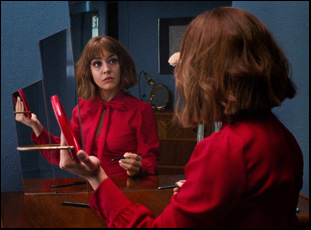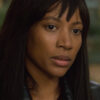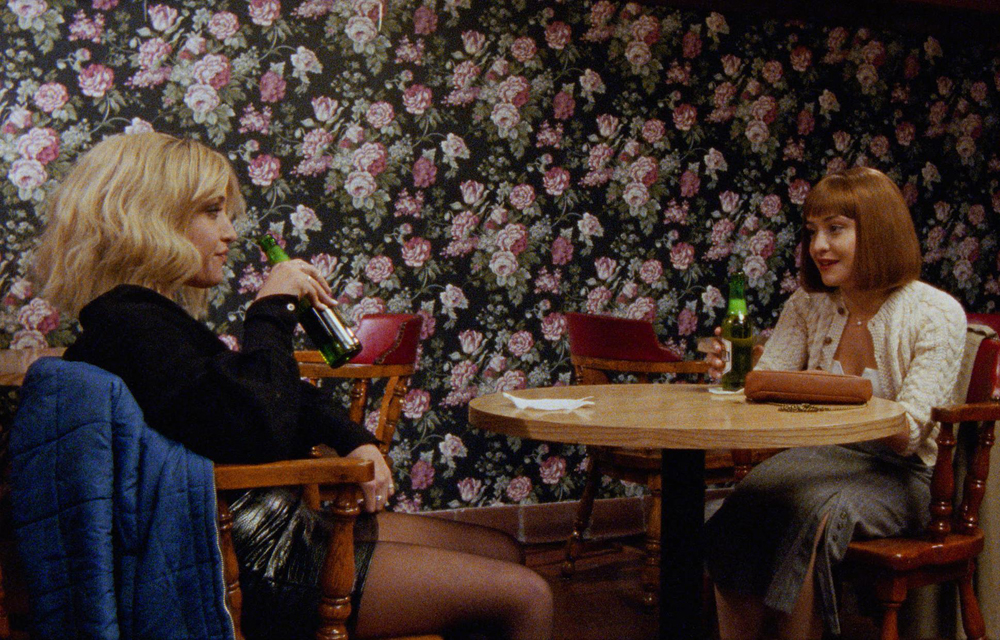It was when there was no ability to concentrate whatsoever that Mia Cioffi Henry pulled everything into focus. It is difficult to speak about the cinematographer’s work without getting personal when she so effortlessly ushers audiences into the intimate space of whoever’s in front of her lens, and it was during the first spring of the pandemic when “The Surrogate,” her first feature as a cinematographer, was supposed to premiere at SXSW that I first found myself in her entirely absorbing compositions, completely taken with the dramatic dynamics at work in Jeremy Hersh’s taut drama about a young woman whose generous decision to carry a child of her friends who can’t conceive backfires spectacularly. While the writer/director crafted conversations that could seem casual and congenial before sharpening to a fine point, Cioffi Henry’s framing would take the opposite tact, often taking quite a specific angle on the film’s star Jasmine Batechelor and allowing the extenuating circumstances around her decisions to reveal themselves as your eye was invited to start wandering around the room, feeling the full weight of the environment she was in.
Cioffi Henry had been bound for a big breakout moment had the pandemic not intervened, when she had two other projects in the can before COVID hit that were equally arresting — Tayler Montague’s Bronx-set short “In Sudden Darkness,” in which a family’s love for one another during a blackout is burnished by candlelight, and “Superior,” a feature expansion of the short she and director Erin Vassilopoulos shot back in 2015. The latter was the culmination of years of collaboration between the two after first meeting at NYU, and like much of their work, it grew out of an irresistibly instantaneously intriguing conceit with identical twin sisters Alessandra and Ani Mesa game to play inseparable siblings who were surprised to find themselves having different reactions to a stranger who shows up at their door in the earlier short. In the feature, Marian (Alessandra Mesa) and Vivian (Ani Mesa) haven’t seen each other for some time, with both tied to a more burdensome partner whether it is Vivian, who is locked into an unhappy marriage with a nettlesome husband (Jake Hoffman) or Vivian, who ends up back in her old home of upstate New York to flee a violent ex-lover (Pico Alexander).
As the two find some solace in their haphazard reconciliation, but perhaps even more in Vivian’s surreptitious suggestion that the two switch places with no one else being the wiser when it offers a look beyond their own life, Cioffi Henry keeps track of both while they’re out confusing everyone else, able to slip into their skin as easily the twins can impersonate one another to see what they do in a cold world, only made more chilly by the winter in Ithaca. The film’s savvy use of 16mm may initially come across like a warm fuzzy sweater, but when the sisters start exploring more uncomfortable territory, any feeling that they’re shrouded by their surroundings is pierced by the cinematographer’s profound sense of perspective, with fear settling into the negative space of a scene while also typically reflecting the unexpected strength that one has within.
Somehow it only seemed appropriate that when I caught up with Cioffi Henry on the eve of the release of “Superior,” she was preternaturally poised in discussing her work on the film while making her way through a line to pick up groceries, generously finding the time to talk during a busy schedule in which she balances the demands of being a working cinematographer with her position at NYU as the Head of 1st Year Studies for Graduate Film and Television, and although I could wonder about how she had the concentration to speak so eloquently while the checkout counter beckoned, I didn’t have to any more about how she’s able to create imagery that allows one to tune the rest of the world out and be completely immersed in the one she envisions. With “Superior” bound to stop people in their tracks, Cioffi Henry kindly used her ability to make time stand still to talk about how she found her way into the camera department through her interest in building characters, bringing the experience she had in between the short she and Vassilopoulos first made and the feature they’d reunite on to bear on their latest work together and what she likes to see in a frame.

Yeah, definitely. I started out as an actor because that’s what was around when you’re a kid, starting in plays and things like that. I came from New York and studied at Stella Adler, but I felt like the actor’s life was not for me and I was really interested in building and design. I loved the idea of space as it related to acting. Blocking was what I was really interested in, so I became a production design major in undergrad and found my way that way through the art department and ended up double majoring in production design and film production. I realized I was spending all this time outside of class doing gels from the lighting department to put together films for our friends, so [cinematography] just felt like a natural transition. Every single step informed the next thing that I’m doing.
Actually, my dad is a DP, so I was around cameras and lighting a lot as a kid, but it just didn’t occur to me that was a job I wanted to do. When you’re a kid, maybe you don’t want to be a lawyer because your parents are lawyers, so had to find it on my own, but once I did, it was this synthesis of all these things that I loved. It was color, it was creative, it was painting with textures and depth and it was movement, creating space and blocking. Then a big holdover from both acting and my design work is understanding the script, the world and the time period and characters’ motivations. I enjoy so much about the preproduction process that really ends up informing a lot of the choices I end up making with lighting and lensing and depth of field, so all of those things inform each of them.
You’re describing what I love so much about your work and this may be terrible to ask without a specific reference, but what goes into a frame for you? You’ll often establish an angle for a scene and then resist moving from it unless absolutely necessary.
Especially working together with Erin [Vassilopoulos] because we’ve worked together so much, but even on my work with Jeremy on “The Surrogate” or other directors that I’ve worked with, I feel like I never want to move the camera unless I absolutely have to. I always like to set myself up into a place that tells the perspective of the characters as best as I can or the perspective that the audience should have on the character. That’s a really big part of understanding the underlying intentions and motivations of the characters and the scene. What is the purpose of this scene in the larger piece? What does the scene say to the viewer and then understanding where we’re supposed to be? Do we have more knowledge than the character? Or do we have less? Are we falling behind them? Are we learning things at the same time? All of those things go into account, as well as what makes a pretty picture. What’s the most interesting angle we can find and how do we infuse movement into that [once] we need to move?
Your films have had a clear signature so far. Have you gravitated towards directors with a similar aesthetic or do you bring that to the table?
Both. I teach in the grad film program at NYU, so I feel like I have an educational mind when it comes to collaboration, whether filmmakers I’m working with like it or not. [laughs] But I’m always looking to collaborate with people who have as strong an intentionality behind what they want to do as me. If they can really talk for hours about what’s on the page and what needs to end up on the screen, I feel I’m in a good pairing. It doesn’t really mean anything to me stylistically where they want to go with something because I feel like I have a breadth to my work and a diversity of images that they don’t belong in one category [or a specific] style, but the underlying vision is the same for all of my work. I try to be multidisciplinary when it comes to genre, but I want to stay strong when it comes to character all the time.
How did you and Erin find each other initially?
We met in film school, the first day at orientation. We sat next to each other and got lunch with a group of other friends and we get assigned a crew in first year, and we ended up in the same crew. It felt like fate because as soon as we started talking about what we liked, our tastes and what we were interested in, we just became obsessed with sending each other images, which has really maintained throughout our entire relationship. I just sent her a picture the other day — even when we’re not working on a project currently, we’re always in other’s mind’s eye.
And we made [“Superior”], the short, in school and in so many ways, we had zero idea what we were doing. [laughs] Myself, especially. But when we finished that film, we were really proud of what we accomplished. It didn’t get the praise we thought it might in school — it wasn’t welcomed so warmly by the faculty and I think people just didn’t understand where we were coming from at first — but then it got into Sundance and it got this broader audience. People really understood what we were trying to do and they really dug what we were trying to explore visually, stylistically, metaphorically with the characters and that felt really great, so returning with the twins eight years later after we first shot it, we felt like going back to school all over again, trying to tap into that really raw feeling that we had when we made that film before we had any kind of pressure.
What was it like getting back on set together after all these years had passed?
We had grown as artists and as filmmakers and in that time in between, we both got married, I had a kid, I moved to another country, I moved back. I shot features. I shot music videos. I shot lots and lots of commercials and we had [gone through all these] different working styles, so we had to mesh those two eras of ourselves into something that did honor this new journey we were on. Once we got into it, we didn’t think that much about the short. Other than the twins, we were the only two [on the original short] even though we had collaborators that we worked with before, so we were really starting fresh in a lot of ways on the feature. We wanted to make sure the feature stood on its own and you didn’t have to have seen the short to understand the feature. But we also wanted to acknowledge it was the same characters, the same world and one storywise comes before the other.
It seems like it’s so stylized, but I remember Erin telling me that house was more or less how you found it and there are some other naturally occurring elements like the snow that found its way into the frame. What was it like embracing what was there?
The house wasn’t quite so wildly painted when we found it. A bit of all of us are in that house — Maite [Perez-Nievas] our production designer really added a lot, and Ally [Pearce], the costume designer. On that first floor, the kitchen was green and the entire living and dining room was pink, so we flipped it around in the end and made the living and dining room monochromatic green walls to match the green carpet and then painted the kitchen that bright pink. Then the upstairs was all blue, and we show an all blue bedroom before on our thesis film “Valeria,” so once we found that bedroom, we were like, “Oh my gosh, same world. Same universe these films are living in.” But we had more surprising references than people realize. Everybody wants to jump to David Lynch or Pedro Almodovar, but we really didn’t look at those. We were influenced so much by “Red Desert” and “Rosemary’s Baby,” and the architecture of that house always looking through doorways and down hallways, and [generally] the muted tones [and how] it feels like things were off sometimes because it’s just so much room.
Is it true Eggleston was an influence? It seems like you might’ve been looking beyond movies.
Yeah, I’ve been pretty obsessed with William Eggleston since my mother gave me a pack of postcards of his photographs. The way he works is so opposite of us, but what comes out of it is so interesting, how he edits down or gets edited down, and just the boldness, the graphic nature of space and the stark framing and really concentrated colors. Finding a candid version of framing that doesn’t always favor the face — looking at people’s backs and people’s profiles — I think we take a lot of that from Eggleston. I’m also a fan of Douglas Sirk and what he does with expressionistic lighting and colors and texture, creating a cinematic world within one frame.
The texture of the format you’re shooting on often tips you off to the feeling of it as well. You were probably locked into 16mm with “Superior” since it’s what you shot the short on, but was it much of a decision?
Yeah, we knew we were going to shoot on film for sure because all of the work [I’ve done with Erin] has been on film thus far and we felt like we were revisiting a world that existed on film. [In film school], we strangely had confidence in it because we collaborated on three films on 16 already at that point, and “Superior” was number four, so I had a pretty strong confidence going into it about what I liked, but I felt like it was the first time I was really commanding a set was on that short. I remember waking up on the second day and being like, “Oh my gosh, I’m a DP. This feels really good.”
We did some camera tests beforehand between 16 and 35. I really wanted to shoot 35 because I thought we should graduate from 16 into something [with] a larger field of capture and a deeper sense of depth. [Erin] wanted to stay [with 16] and ultimately once she started looking at the locations and we found that little house, it was a complete no-brainer to go with 16. We needed to be nimble. We needed to film in very small spaces — lots of car stuff — [and it helped with] pace on set because when you’re working on independent film, you don’t have a ton of support, so you need to be able to work quick. I can’t even imagine the film on 35, it would’ve been too crazy.
But I think texture is definitely a piece of shooting on film and people love to talk about the graininess of film, but what I see more is a three-dimensionality that happens and takes on a much more organic quality. It’s much easier to create depth with film because of the way it treats light and lets light fall off in a really appealing way. When you’re shooting digital, you’re seeing into the shadows all the time because you’ve got that high S-O often and you get that natural falloff. Shooting into the shadows is sometimes nice when you can light a scene with one light, but to create that sense of mystery, that sense of things behind the corners I feel like shooting on film is so great for that because it fills in for you. It creates a lot of sense of mystery and I always feel like it has half my job just by turning the camera on on film.
I feel you have something to do with it…
Anyone could do what I do.
I’ll disagree with you there, and you’ve really shown your range over the past two years. Does it feel like you’ve been having a breakout moment, even in spite of the pandemic?
Yeah, it definitely opens doors. So much in the industry is not just creating images and getting to talk about characters and lighting plans and film grade and all of that. So much is about who you know and who knows you and having your work out there. [“Superior”] is my third film to have been at Sundance and it opens a lot of doors, but it’s still hard for filmmakers to get people to trust them with bigger budgets and with deeper stories, so I feel like I’m still trying to figure out what my next feature is.
I haven’t shot anything since “Superior,” one because of COVID, but two because I feel the right material hasn’t come across my desk just yet, so I’m waiting for the right thing that really grabs me and I feel like I could do a good job at. I don’t do good work when I’m only tangentially connected to something. I want to really feel myself and see myself in the work. That’s why my work has a throughline because the throughline is my connection and my feelings about the characters and how I see myself in the stories.
“Superior” opens on March 25th at the BAMCinematek in New York and the Circle Cinema in Tulsa. It will open in Los Angeles at the Laemmle Glendale on April 1st.




